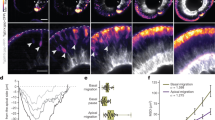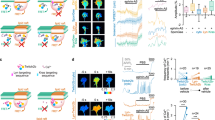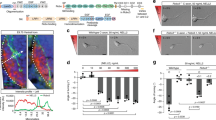Abstract
Cell adhesion molecules and diffusible cues both regulate axon pathfinding, yet how these two modes of signaling interact is poorly understood. The homophilic cell adhesion molecule NF-protocadherin (NFPC) is expressed in the mid-dorsal optic tract neuroepithelium and in the axons of developing retinal ganglion cells (RGC) in Xenopus laevis. Here we report that targeted disruption of NFPC function in RGC axons or the optic tract neuroepithelium results in unexpectedly localized pathfinding defects at the caudal turn in the mid-optic tract. Semaphorin 3A (Sema3A), which lies adjacent to this turn, stimulates rapid, protein synthesis–dependent increases in growth cone NFPC and its cofactor, TAF1, in vitro. In vivo, growth cones exhibit marked increases in NFPC translation reporter activity in this mid-optic tract region that are attenuated by blocking neuropilin-1 function. Our results suggest that translation-linked coupling between regionally localized diffusible cues and cell adhesion can help axons navigate discrete segments of the pathway.
This is a preview of subscription content, access via your institution
Access options
Subscribe to this journal
Receive 12 print issues and online access
$209.00 per year
only $17.42 per issue
Buy this article
- Purchase on Springer Link
- Instant access to full article PDF
Prices may be subject to local taxes which are calculated during checkout








Similar content being viewed by others
References
Chien, C.B., Rosenthal, D.E., Harris, W.A. & Holt, C.E. Navigational errors made by growth cones without filopodia in the embryonic Xenopus brain. Neuron 11, 237–251 (1993).
Harris, W.A. Local positional cues in the neuroepithelium guide retinal axons in embryonic Xenopus brain. Nature 339, 218–221 (1989).
Atkinson-Leadbeater, K. et al. Dynamic expression of axon guidance cues required for optic tract development is controlled by fibroblast growth factor signaling. J. Neurosci. 30, 685–693 (2010).
Campbell, D.S. et al. Semaphorin 3A elicits stage-dependent collapse, turning, and branching in Xenopus retinal growth cones. J. Neurosci. 21, 8538–8547 (2001).
Piper, M. et al. Signaling mechanisms underlying Slit2-induced collapse of Xenopus retinal growth cones. Neuron 49, 215–228 (2006).
Arikkath, J. & Reichardt, L.F. Cadherins and catenins at synapses: roles in synaptogenesis and synaptic plasticity. Trends Neurosci. 31, 487–494 (2008).
Hirano, S., Suzuki, S. & Redies, C. The cadherin superfamily in neural development: diversity, function and interaction with other molecules. Front. Biosci. 8, d306–d355 (2003).
Takeichi, M. The cadherin superfamily in neuronal connections and interactions. Nat. Rev. Neurosci. 8, 11–20 (2007).
Bradley, R.S., Espeseth, A. & Kintner, C. NF-protocadherin, a novel member of the cadherin superfamily, is required for Xenopus ectodermal differentiation. Curr. Biol. 8, 325–334 (1998).
Heggem, M.A. & Bradley, R.S. The cytoplasmic domain of Xenopus NF-protocadherin interacts with TAF1/set. Dev. Cell 4, 419–429 (2003).
Rashid, D., Newell, K., Shama, L. & Bradley, R. A requirement for NF-protocadherin and TAF1/Set in cell adhesion and neural tube formation. Dev. Biol. 291, 170–181 (2006).
Piper, M., Dwivedy, A., Leung, L., Bradley, R.S. & Holt, C.E. NF-protocadherin and TAF1 regulate retinal axon initiation and elongation in vivo. J. Neurosci. 28, 100–105 (2008).
Campbell, D.S. & Holt, C.E. Chemotropic responses of retinal growth cones mediated by rapid local protein synthesis and degradation. Neuron 32, 1013–1026 (2001).
Leung, K.-M. et al. Asymmetrical β-actin mRNA translation in growth cones mediates attractive turning to netrin-1. Nat. Neurosci. 9, 1247–1256 (2006).
Lin, A.C. & Holt, C.E. Local translation and directional steering in axons. EMBO J. 26, 3729–3736 (2007).
Wu, K.Y. et al. Local translation of RhoA regulates growth cone collapse. Nature 436, 1020–1024 (2005).
Yao, J., Sasaki, Y., Wen, Z., Bassell, G.J. & Zheng, J.Q. An essential role for β-actin mRNA localization and translation in Ca2+-dependent growth cone guidance. Nat. Neurosci. 9, 1265–1273 (2006).
Falk, J. et al. Electroporation of cDNA/morpholinos to targeted areas of embryonic CNS in Xenopus. BMC Dev. Biol. 7, 107 (2007).
Holt, C.E. A single-cell analysis of early retinal ganglion cell differentiation in Xenopus: from soma to axon tip. J. Neurosci. 9, 3123–3145 (1989).
Piper, M., Salih, S., Weinl, C., Holt, C.E. & Harris, W.A. Endocytosis-dependent desensitization and protein synthesis-dependent resensitization in retinal growth cone adaptation. Nat. Neurosci. 8, 179–186 (2005).
Lin, A.C. et al. Cytoplasmic polyadenylation and cytoplasmic polyadenylation element-dependent mRNA regulation are involved in Xenopus retinal axon development. Neural Dev. 4, 8 (2009).
Leung, K.-M. & Holt, C.E. Live visualization of protein synthesis in axonal growth cones by microinjection of photoconvertible Kaede into Xenopus embryos. Nat. Protoc. 3, 1318–1327 (2008).
Uemura, M., Nakao, S., Suzuki, S.T., Takeichi, M. & Hirano, S. OL-protocadherin is essential for growth of striatal axons and thalamocortical projections. Nat. Neurosci. 10, 1151–1159 (2007).
Garrett, A.M., Schreiner, D., Lobas, M.A. & Weiner, J.A. γ-Protocadherins control cortical dendrite arborization by regulating the activity of a FAK/PKC/MARCKS signaling pathway. Neuron 74, 269–276 (2012).
Lefebvre, J.L., Kostadinov, D., Chen, W.V., Maniatis, T. & Sanes, J.R. Protocadherins mediate dendritic self-avoidance in the mammalian nervous system. Nature 488, 517–521 (2012).
Yasuda, S. et al. Activity-induced protocadherin arcadlin regulates dendritic spine number by triggering N-cadherin endocytosis via TAO2β and p38 MAP kinases. Neuron 56, 456–471 (2007).
Garrett, A.M. & Weiner, J.A. Control of CNS synapse development by γ-protocadherin-mediated astrocyte-neuron contact. J. Neurosci. 29, 11723–11731 (2009).
Williams, E.O. et al. Delta protocadherin 10 is regulated by activity in the mouse main olfactory system. Front. Neural Circuits 5, 9 (2011).
Lefebvre, J.L., Zhang, Y., Meister, M., Wang, X. & Sanes, J.R. γ-Protocadherins regulate neuronal survival but are dispensable for circuit formation in retina. Development 135, 4141–4151 (2008).
Castellani, V., De Angelis, E., Kenwrick, S. & Rougon, G. Cis and trans interactions of L1 with neuropilin-1 control axonal responses to semaphorin 3A. EMBO J. 21, 6348–6357 (2002).
Castellani, V., Falk, J. & Rougon, G. Semaphorin3A-induced receptor endocytosis during axon guidance responses is mediated by L1 CAM. Mol. Cell. Neurosci. 26, 89–100 (2004).
Bechara, A. et al. FAK-MAPK-dependent adhesion disassembly downstream of L1 contributes to semaphorin3A-induced collapse. EMBO J. 27, 1549–1562 (2008).
Falk, J. et al. Dual functional activity of semaphorin 3B is required for positioning the anterior commissure. Neuron 48, 63–75 (2005).
Wolman, M.A., Regnery, A.M., Becker, T., Becker, C.G. & Halloran, M.C. Semaphorin3D regulates axon–axon interactions by modulating levels of L1 cell adhesion molecule. J. Neurosci. 27, 9653–9663 (2007).
Nawabi, H. et al. A midline switch of receptor processing regulates commissural axon guidance in vertebrates. Genes Dev. 24, 396–410 (2010).
Kuwajima, T. et al. Optic chiasm presentation of Semaphorin6D in the context of Plexin-A1 and Nr-CAM promotes retinal axon midline crossing. Neuron 74, 676–690 (2012).
Lemmon, V., Burden, S.M., Payne, H.R., Elmslie, G.J. & Hlavin, M.L. Neurite growth on different substrates: permissive versus instructive influences and the role of adhesive strength. J. Neurosci. 12, 818–826 (1992).
Goodman, C.S. Mechanisms and molecules that control growth cone guidance. Annu. Rev. Neurosci. 19, 341–377 (1996).
Barnes, S.H., Price, S.R., Wentzel, C. & Guthrie, S.C. Cadherin-7 and cadherin-6B differentially regulate the growth, branching and guidance of cranial motor axons. Development 137, 805–814 (2010).
Shima, Y. et al. Opposing roles in neurite growth control by two seven-pass transmembrane cadherins. Nat. Neurosci. 10, 963–969 (2007).
Nakao, S., Platek, A., Hirano, S. & Takeichi, M. Contact-dependent promotion of cell migration by the OL-protocadherin-Nap1 interaction. J. Cell Biol. 182, 395–410 (2008).
Brittis, P.A., Lu, Q. & Flanagan, J.G. Axonal protein synthesis provides a mechanism for localized regulation at an intermediate target. Cell 110, 223–235 (2002).
Kuwako, K. et al. Neural RNA-binding protein Musashi1 controls midline crossing of precerebellar neurons through posttranscriptional regulation of Robo3/Rig-1 expression. Neuron 67, 407–421 (2010).
Zivraj, K.H. et al. Subcellular profiling reveals distinct and developmentally regulated repertoire of growth cone mRNAs. J. Neurosci. 30, 15464–15478 (2010).
Seo, S.B. et al. Regulation of histone acetylation and transcription by INHAT, a human cellular complex containing the Set oncoprotein. Cell 104, 119–130 (2001).
Nieuwkoop, F.J. & Faber, J. Normal Table of Xenopus laevis (Daudin) (North-Holland, 1967).
Scotto-Lavino, E., Du, G. & Frohman, M.A. 3′ end cDNA amplification using classic RACE. Nat. Protoc. 1, 2742–2745 (2006).
Leung, L. & Holt, C.E. Imaging axon pathfinding in Xenopus in vivo. Cold Spring Harb. Protoc. 2012, 984–991 (2012).
Wizenmann, A. et al. Extracellular engrailed participates in the topographic guidance of retinal axons in vivo. Neuron 64, 355–366 (2009).
Luo, Y., Raible, D. & Raper, J.A. Collapsin: a protein in brain that induces the collapse and paralysis of neuronal growth cones. Cell 75, 217–227 (1993).
Acknowledgements
We thank R. Bradley (Montana State University) for kind gifts of NFPC antibody and sharing constructs, S. McFarlane for advice on the Slit1 in situ hybridization, and F. van Horck for NFPC in situ hybridization data. We thank A. Pungaliya, A. McNabb, T. Dyl, G. Stooke-Vaughan, C. Purmann, K. Holmes, H. Lynn, G. Lupo, D. Maurus and N. Coutts for technical assistance. We thank members of the Harris and Holt laboratories for assistance and comments on the manuscript. This work was funded by Wellcome Trust Programme grant no. 085314/Z/08/Z (C.E.H., W.A.H.), a UK Medical Research Council Doctoral Training Grant (L.C.L.), a Wellcome Trust Studentship (V.U.), the National Science and Engineering Research Council of Canada and the Alberta Heritage Foundation for Medical Research (M-L.B.), a UK Medical Research Council studentship (T.G.B.) and an EMBO fellowship (A.C.L.).
Author information
Authors and Affiliations
Contributions
L.C.L., C.E.H. and W.A.H. conceived the project, designed the experiments and wrote the manuscript. L.C.L. produced the constructs and peptides, and generated and analyzed all the data in Figures 1,2,3,4,5,6,7, and Supplementary Figures 1–7 unless otherwise stated. V.U. and T.G.B. performed and analyzed the in vivo Kaede translation reporter experiments in Figure 8a,b. V.U. conducted the combined antibody in vivo Kaede reporter experiments in Figure 8c,d and A.D. assisted with in vivo antibody experiments in Supplementary Figure 4e. M.-L.B. performed in situ hybridization in Supplementary Figure 3. A.C.L. performed the western blots in Supplementary Figure 1a,b and the cycloheximide experiments in Supplementary Figure 5n.
Corresponding author
Ethics declarations
Competing interests
The authors declare no competing financial interests.
Supplementary information
Supplementary Text and Figures
Supplementary Figures 1–8 and Supplementary Table 1 (PDF 21990 kb)
Supplementary Video 1
Timelapse movie of a GAP-GFP axon. An example of a timelapse movie of GAP-GFP axons navigating through the Xenopus optic tract (lateral view), from which the kymograph in Figure 3a was derived. Each frame represents 3 min elapsed and the movie is played at 5 frames per second. This movie was acquired at 20× magnification. Scale bar, 10 μm. (MOV 517 kb)
Supplementary Video 2
Timelapse movie of a NFΔEeGFP axon. An example of a timelapse movie of an NFΔEeGFP axon navigating through the Xenopus optic tract, from which the kymograph in Figure 3b was derived. Each frame represents 3 min elapsed and the movie is played at 5 frames per second. The growth cone has stalled at the caudal turn, and once it has made the turn growth in the dorsal tract is appreciably slower. This movie was acquired at 20× magnification. Scale bar, 10 μm. (MOV 574 kb)
Supplementary Video 3
Timelapse movie of Kaede-NFPC-3′UTR translation activity in the ventral optic tract. An example of a retinal growth cone in the ventral optic tract (arrowheads), expressing Kaede-NFPC-3′UTR, in which the green signal is not recovered over the course of 30 min, indicative of the absence of NFPC-3′UTR–driven translation in the ventral optic tract. Each frame represents 5 min and the movie is played at 1.5 frames per second. The timelapse was acquired at 60× magnification. Scale bar, 5 μm. (MOV 329 kb)
Supplementary Video 4
Timelapse movie of Kaede-NFPC-3′UTR translation activity in the mid-optic tract. Photoconversion and post-conversion imaging of Kaede in retinal growth cones expressing Kaede-NFPC-′UTR in the mid-optic tract. Arrowheads highlight a single growth cone in which the green signal recovers over the course of 30 min after photoconversion, indicative of the translation of Kaede-NFPC-3′UTR. Magnification and playback speed are as in Supplementary Movie 3. (MOV 330 kb)
Supplementary Video 5
Timelapse movie of Kaede-NFPC-3′UTR translation in brains treated with a control antibody. An example of a retinal growth cone in mid-optic tract with Kaede-green signal recovery after photoconversion, following incubation with a control (IgG2B) antibody. Magnification and playback speed are as in Supplementary Video 3. (MOV 459 kb)
Supplementary Video 6
Timelapse movie of Kaede-NFPC-3′UTR translation in brains treated with a neuropilin-1 function blocking antibody. An example of a retinal growth cone in mid-optic tract with a reduced level of Kaede-green signal recovery after photoconversion following incubation with a neuropilin-1 function-blocking antibody, indicative of decreased translation of Kaede-NFPC-3′UTR upon anti–NP-1 treatment. Magnification and playback speed are as in Supplementary Video 3. (MOV 361 kb)
Rights and permissions
About this article
Cite this article
Leung, L., Urbančič, V., Baudet, ML. et al. Coupling of NF-protocadherin signaling to axon guidance by cue-induced translation. Nat Neurosci 16, 166–173 (2013). https://doi.org/10.1038/nn.3290
Received:
Accepted:
Published:
Issue Date:
DOI: https://doi.org/10.1038/nn.3290
This article is cited by
-
Neuronal subtype-specific growth cone and soma purification from mammalian CNS via fractionation and fluorescent sorting for subcellular analyses and spatial mapping of local transcriptomes and proteomes
Nature Protocols (2022)
-
Endoplasmic Reticulum in Metaplasticity: From Information Processing to Synaptic Proteostasis
Molecular Neurobiology (2022)
-
Axonal mRNA localization and translation: local events with broad roles
Cellular and Molecular Life Sciences (2021)
-
Depression and suicide risk prediction models using blood-derived multi-omics data
Translational Psychiatry (2019)
-
Local translation in neurons: visualization and function
Nature Structural & Molecular Biology (2019)



